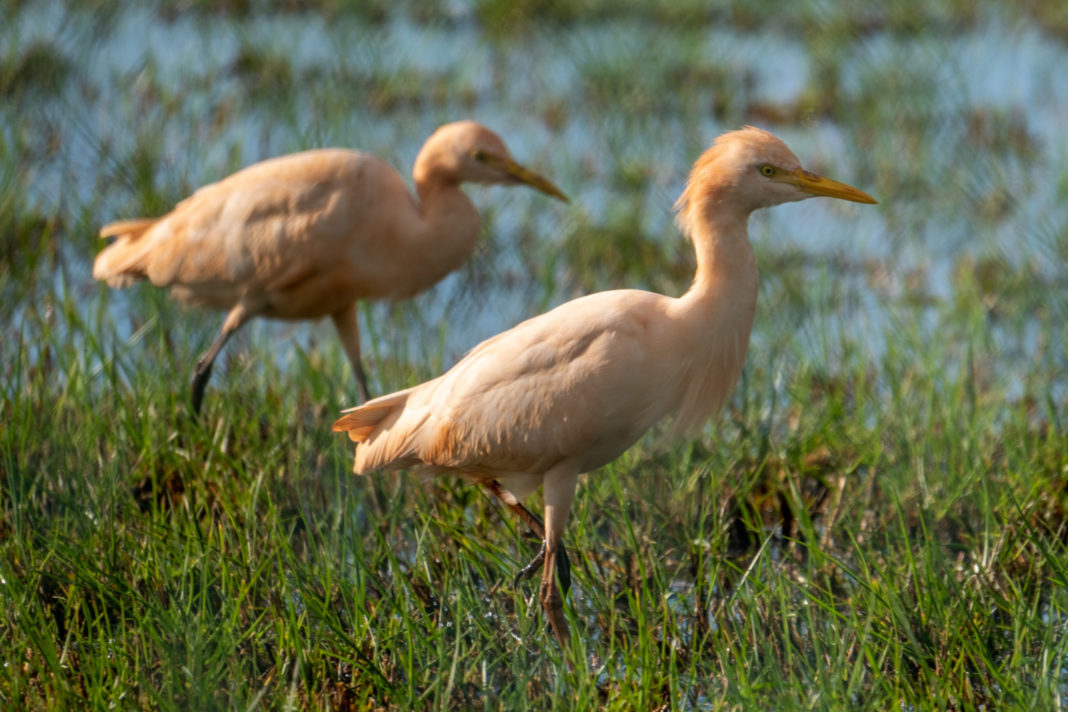When I first pulled up I thought I was seeing a half-dozen young roseate spoonbills on the side road that parallels the runway at Marathon airport. It would have been kind of ironic, because I’d just spent a couple days up in the Everglades, where spoonbills are supposed to be this time of year, and I didn’t manage to see any. After a moment, though, I realized I wasn’t seeing pink but orange, a forgivable confusion, as both are colors found in a bowl of Froot Loops, and the hues and intensities are pretty similar.
The birds were on the runway side of the fence and their orange was not as intense as, say, an orange-grove orange, but something closer to an apricot or a peach, or a hybrid of the two. (Apparently there is a stone fruit called a peachcot, which is a hybrid of a peach and an apricot, but whose color is a little too yellow to describe the birds.)

Besides their color, the six birds were shaped differently than spoonbills, which look like weirdly glamorous flying dinosaurs. Cattle egrets may be the least elegant wading bird on the planet. On their best days they look kind of scrappy, but most of the time they look like they’re punching the clock at a 40-hour-a-week middle-management gig in the wading bird union, which was the only position they could find after graduating bird college. Also, cattle egrets are about two-thirds the size of roseate spoonbills. And their bills don’t look like spoons so much as square-cut masonry nails.
As a general rule, cattle egrets are white. In breeding season they can develop brown patches on the breast and back, as well as the back of the head and neck. (They’re one of the few species that go earth-toned to attract a mate.) But I’d never seen full body coloration like that before.
I immediately recalled seeing a series of photos from a few years back of a “curry gull” in England that looked very similar. The “curry gull,” it turned out, was not a species previously unknown to science, but a regular old herring gull that had somehow gotten into a bag of curry powder or turmeric – nobody is sure which and apparently no one tasted the bird to see – and dyed itself a similar shade of orange.
I wondered if it was possible for six cattle egrets to somehow fall into a bag of curry powder, or possibly turmeric, but it seemed unlikely, as there are not many Indian restaurants in the Keys. (Though if you haven’t tried the recently opened Tikka Bar on Greene Street, you should. It’s really good.) Also, birds’ feathers require a lot of maintenance and preening in order to stay functional, and you could see in the photos of the curry gull that its feathers were all gunked up. So much so that it had to be captured and cleaned by the local wildlife rescue people.
Researchers trying to understand bird behavior will sometimes catch and dye their subjects, but they tend to choose unnatural looking colors – I saw a pink Peregrine falcon once – and birds that were being studied that way would also, most likely, have metal or plastic bands on their legs.
My field guide pointed out that some cattle egrets do on occasion show more extensive brown patches in breeding season, but the illustrations showed them covering about a third of their body, not all of it.
When I got home and did further reading, I saw some references to orange or peach-colored birds being seen in twos or threes on rare occasions in South Florida. Also, records of aberrant plumage birds in India. (Cattle egrets were originally from Asia and Africa, but have been spreading themselves around the globe in recent centuries. They first appeared in the U.S. in 1953 and have extended their range all the way to California and Canada since.)
David Sibley, author of the “Sibley Guide to Birds,” has a blog where he muses somewhat informally about things ornithological. He wrote two blog entries about peachy-orange cattle egrets in 2012 after readers sent him photos of birds similar to the ones I saw.
Sibley pointed out that while most birds get their breeding plumage by molting dull feathers and replacing them with more brightly pigmented ones, cattle egrets do it differently (as do some parrots, some other herons, as well as birds in the tinamou and bustard families). Their dark feathers come from something called cosmetic coloration.
Cattle egrets have special down feathers that disintegrate at the exposed ends into a dark, slightly oily talcum-like substance known as powder-down. Unlike most feathers, powder-down feathers grow continually, kind of like human hair. The birds spread this through their other feathers as breeding season approaches, and this tints the feathers into their more eye-catching hues.
Sibley speculated that the full-body coloration may be the result of the bird over-producing the oils in its powder-down, and the color therefore spreading. Seeing six similarly aberrant birds at the same time makes me speculate that excessively oily powder-down may be a genetic trait, since how else could you explain such a cluster of oddly colored birds? But that’s speculating upon someone else’s speculation, which feels like some pretty shaky ground.
It might be the kind of thing there’s never a clear answer to. Unless someone opened an Indian restaurant in the Middle Keys I don’t know about.
























